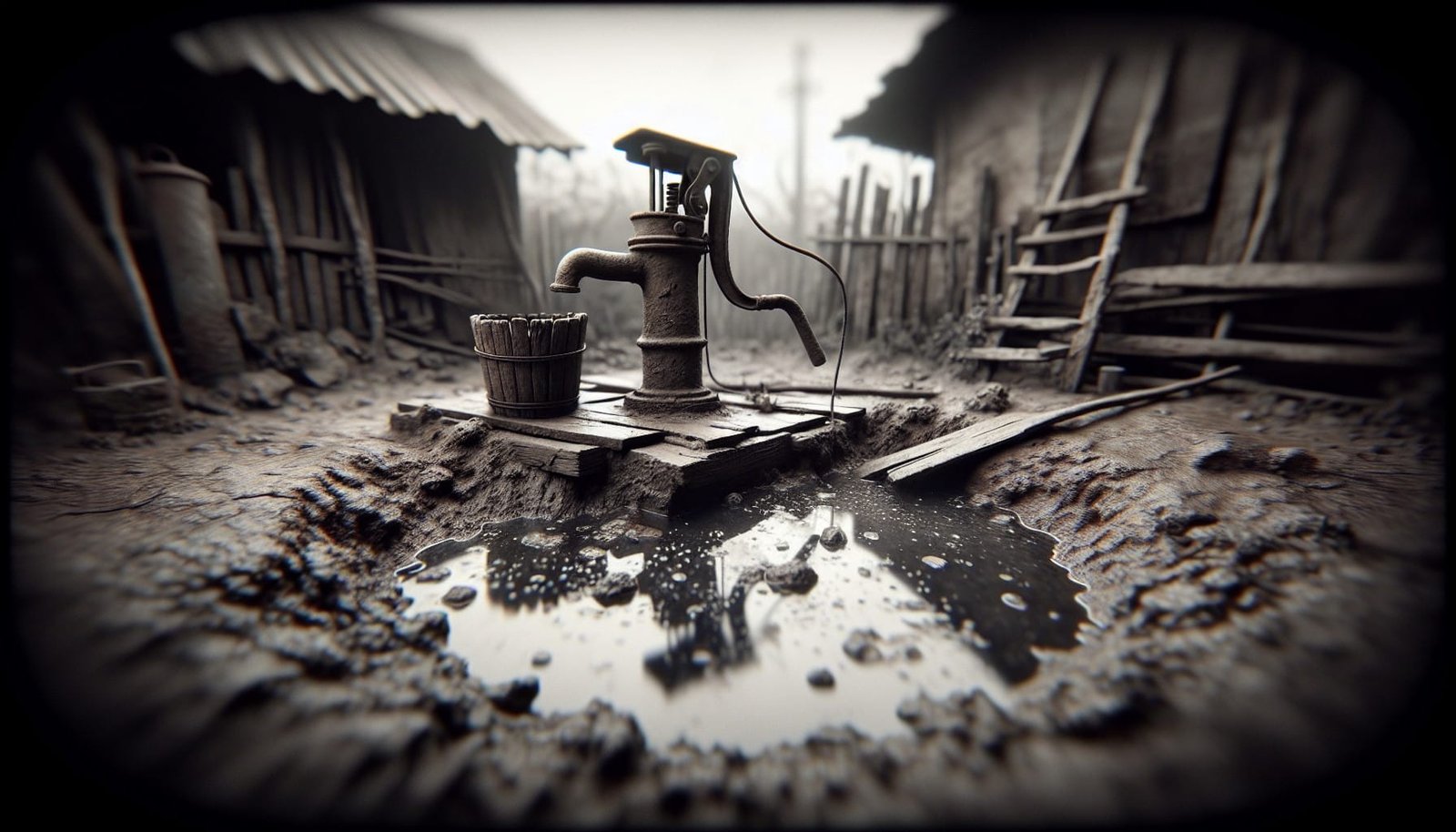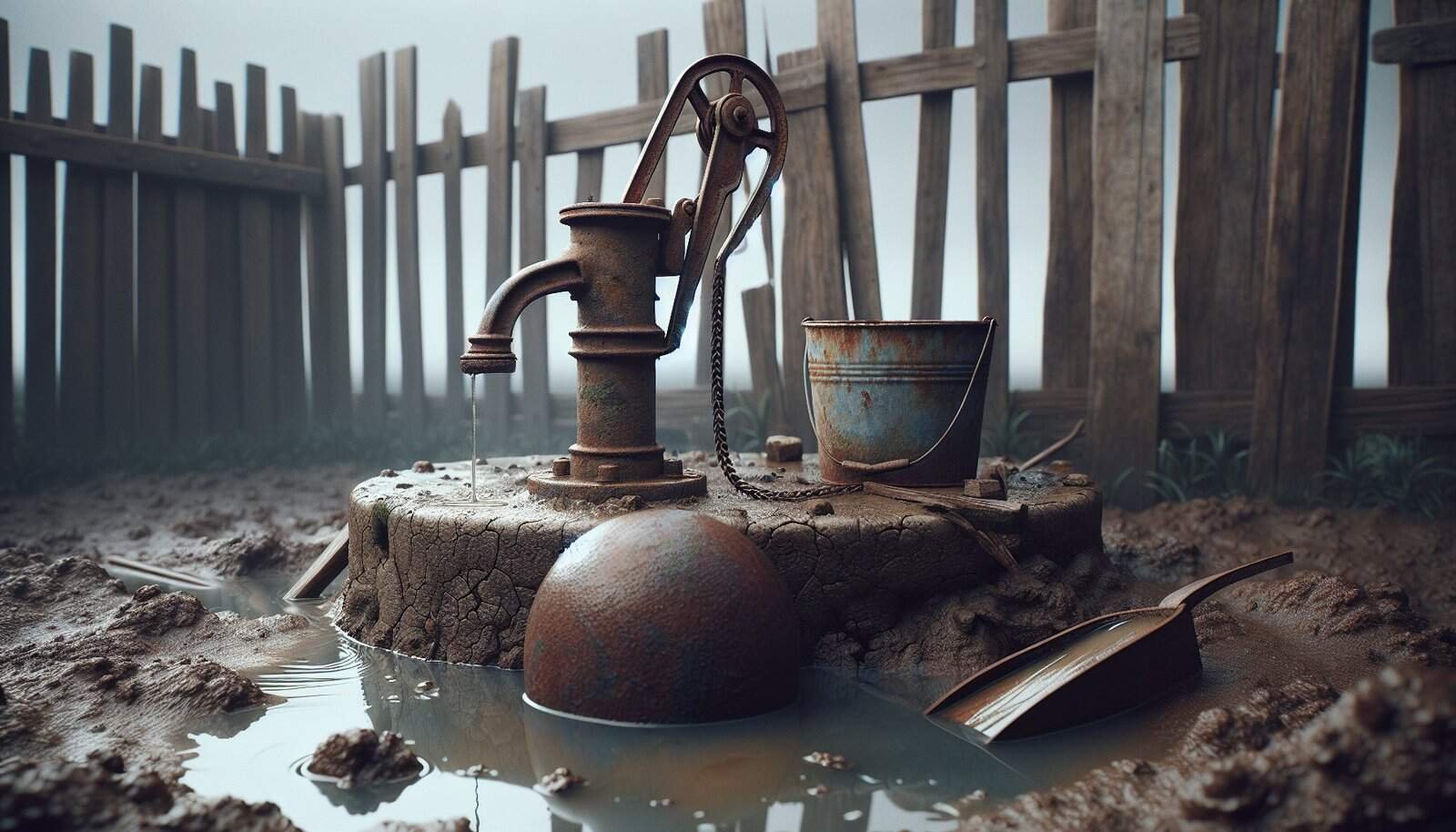Have you thought about what might be flowing into the shallow well on your property?
What Are The Risks Of Shallow Water Wells?
Shallow water wells can be an economical way to access groundwater, but they come with distinct vulnerabilities you should understand. This article explains the risks, how they affect your health and property, how to test and respond, and steps you can take to reduce danger to your water supply.
What is a shallow water well?
A shallow water well is typically a well with a depth of less than about 50 feet, although definitions vary by region. These wells are often dug, bored, or driven rather than drilled, and they draw water from near-surface aquifers that are more directly connected to surface conditions.
Types and construction methods
Shallow wells are usually constructed by digging or boring a large-diameter hole, driving a screened pipe into a sand or gravel layer, or using an auger to create a shallow bore. The construction method affects vulnerability: dug wells with open tops are generally more exposed to contamination than properly cased driven wells.
How shallow wells differ from deeper wells
Because shallow wells tap near-surface groundwater, they respond quickly to rainfall, runoff, and local land-use impacts. Deeper drilled wells often reach confined aquifers separated from surface activities by layers of low-permeability material, so they tend to be less immediately affected by surface contamination.

Common risks to water quality
Shallow wells face a range of water quality threats that can come from both natural sources and human activities. Understanding these risks helps you decide on testing frequency, treatment options, and site management.
Microbial contamination
Surface runoff, animal waste, failing septic systems, and nearby livestock operations can introduce bacteria, viruses, and protozoa into shallow groundwater. Total coliforms and E. coli are commonly tested indicators; their presence often signals recent fecal contamination and potential disease-causing organisms.
Nitrate and nitrite contamination
Nitrate often comes from fertilizers, septic systems, and agricultural manure. Because nitrates are highly soluble, they move easily through shallow soils to groundwater. High nitrate in drinking water can cause serious problems for infants (methemoglobinemia or “blue baby” syndrome) and can indicate broader contamination from human or animal waste.
Chemical contamination: pesticides, solvents, and petroleum
Pesticides, herbicides, and volatile organic compounds (VOCs) used around homes and farms can percolate into shallow aquifers. Spills, improper disposal, and historic land use may leave residues that persist in groundwater and are not eliminated by simple boiling.
Heavy metals and geogenic contaminants
Some contaminants come from the geology itself. Arsenic, manganese, iron, and sometimes lead or uranium can be present naturally or become mobilized by changes in pH or redox conditions. Shallow wells can show variable levels depending on local soil and bedrock conditions.
Seasonal and drought impacts
Shallow water tables fluctuate with wet and dry seasons. During droughts, wells can run dry or pull in lower-quality water from near-surface sources. Conversely, heavy rains can cause sudden spikes in contaminants as surface water percolates quickly into the aquifer.
Flooding and surface water influence
Floods can contaminate shallow wells by directly introducing surface water that contains pathogens, chemicals, and debris. After flooding, wells can remain contaminated until properly disinfected and tested.
Well construction and integrity risks
Poorly sealed or cased wells, damaged casings, missing well caps, or inadequate grout around the casing provide direct routes for contamination. Abandoned wells that are not sealed also act as conduits between surface water and deeper groundwater.
Cross-connections and backflow risks
Improper plumbing, failed check valves, or backflow from hoses and irrigation systems can introduce contaminated water into your well or household plumbing. Backflow prevention and proper pressure systems are essential to protect your water supply.
Health risks and symptoms
Contaminated well water can cause a range of health problems, from short-term gastrointestinal illness to long-term chronic conditions. Knowing the likely symptoms can help you decide when to seek medical attention and act quickly.
Short-term illnesses
Microbial contamination commonly causes nausea, vomiting, diarrhea, and stomach cramps. Children, elderly people, and immunocompromised individuals are especially vulnerable to severe dehydration or secondary complications.
Long-term health effects
Chronic exposure to contaminants like arsenic, nitrates, some VOCs, and heavy metals can increase your risk of cancer, developmental problems in children, reproductive issues, and neurological effects. Long-term exposure tends to be less obvious than acute illness but can have serious consequences over years.

Environmental and property risks
Contaminated groundwater can affect not only your drinking supply but also crops, livestock, and property value. If contamination is traced to an activity on your property, you may face cleanup costs and regulatory requirements. Additionally, failing wells or frequent pump problems increase maintenance expenses and reduce property usability.
How to test your shallow well
Testing is the most reliable way to know what’s in your water. You should set up a regular testing schedule and test after any event that could contaminate the well, such as flooding, septic system failure, nearby chemical spills, or unusual taste or odor.
Recommended testing parameters and frequency
Testing frequency and parameters depend on local risks, but the table below outlines common recommendations. Follow local health department or state guidance as it may differ.
| Parameter | Why it matters | Recommended frequency | When to test immediately |
|---|---|---|---|
| Total coliforms & E. coli | Indicates microbial contamination that can cause illness | Annually; after repairs; after floods | After flooding, septic malfunction, or illness in household |
| Nitrate/Nitrite | Indicates fertilizer/septic influence; health risk for infants | Annually | Sudden change in color or smell; after fertilizer application nearby |
| pH & Conductivity/TDS | General water chemistry and salinity; affects treatment | Annually | When treatment equipment behaves oddly |
| Iron & Manganese | Staining, taste, and plumbing issues | Every 1–3 years | If water stains fixtures or tastes metallic |
| Lead & Copper | Plumbing corrosion and health risks | Every 1–3 years; after plumbing changes | If you have old piping or recent plumbing work |
| Arsenic | Serious long-term health risk; can be natural | Every 3–5 years; more often if local geology suggests risk | If local tests or neighbors show arsenic present |
| VOCs & Petroleum hydrocarbons | Solvents, fuels affect health and taste | Every 3–5 years or if nearby industrial activity | After a spill or construction near property |
| Pesticides/Herbicides | Agricultural runoff or home use | Every 3–5 years; more often if near fields | After major pesticide application nearby |
| Sulfate, chloride | Affects taste and corrosion | Every 2–3 years | If water becomes noticeably bitter or salty |
| Radon (in water) | Gas that causes lung cancer when released to air | Test once if local geology suggests | If region has known radon issues |

How to interpret test results
You should compare results to your local or national standards and health guidance. For the U.S., EPA sets Maximum Contaminant Levels (MCLs) for public systems, but private wells are not regulated federally; use EPA MCLs and state recommendations as guidance.
If bacterial contamination is present, the water is considered unsafe for drinking unless treated. For chemical contaminants, exceedance of recommended limits requires action that may include treatment, alternative water sources, or well remediation.
Immediate actions if contamination is detected
If your water tests positive for bacteria or shows dangerous chemical levels, stop using the water for drinking and food preparation immediately. Use bottled water or an alternate safe source until you stabilize or treat the well.
Do not assume boiling will fix chemical contamination — boiling removes pathogens but concentrates dissolved chemicals and metals. For bacterial contamination, shock chlorination, followed by retesting, is a common first response. For chemical contamination, contact a qualified well contractor or environmental professional for guidance.

Treatment and remediation options
Your treatment choice depends on the contaminant type, concentration, water chemistry, and household needs. Some solutions are relatively inexpensive and effective; others are complex and costly.
Disinfection: shock chlorination
Shock chlorination involves introducing a high concentration of chlorine into the well and plumbing system to kill bacteria. It is effective against many bacterial pathogens but does not remove chemical contaminants, and it may not reach biofilms or deep contamination without thorough application.
Filtration: sediment and particulate filters
Sediment filters remove suspended solids that affect taste, clogging, and appearance. These filters are inexpensive, simple to maintain, and protect downstream equipment and point-of-use devices.
Activated carbon adsorption
Granular activated carbon (GAC) filters remove many organic chemicals, pesticides, and some taste and odor compounds. GAC is effective for many VOCs and some small molecules but must be maintained and replaced to avoid breakthrough and bacterial growth.
Ion exchange and water softening
Ion exchange systems (water softeners) can remove hardness (calcium, magnesium) and reduce some positively charged contaminants like certain metals. They are not effective for most VOCs or anions such as nitrate and typically require regeneration chemicals.
Reverse osmosis (RO)
RO systems provide high-quality point-of-use water by forcing water through a semi-permeable membrane, removing many dissolved salts, metals, and some organic chemicals. RO is often used for drinking water but wastes a portion of water and requires prefiltration and maintenance.
Distillation
Distillation can remove most contaminants, including microbes and many chemicals, by vaporizing and condensing water. It is energy-intensive and typically used as a point-of-use solution.
Aeration and oxidation
For contaminants like radon or volatile organic compounds, aeration systems strip gases from water. Oxidation followed by filtration (e.g., for iron, manganese, or some arsenic forms) converts soluble species to insoluble particles that can be filtered out.
Specialized treatments for arsenic and nitrate
Arsenic often requires specific media (e.g., iron-based sorbents) or reverse osmosis for effective removal. Nitrate is commonly treated with ion exchange, reverse osmosis, or biological denitrification systems; choices depend on household scale and concentration.
Well repair or replacement
If contamination is due to poor construction, repairing the well casing, replacing caps, regrouting, or installing a deeper well may be necessary. In severe contamination scenarios, abandoning an old well and drilling a properly constructed deeper well can be the most reliable long-term solution.
Treatment comparison table
| Treatment | Targets | Pros | Cons | Typical cost range* |
|---|---|---|---|---|
| Shock chlorination | Bacteria | Fast, inexpensive | Not for chemicals; may not remove biofilms | $50–$250 (DIY or contractor) |
| Sediment filters | Particulates | Low cost, protects other equipment | Doesn’t remove dissolved contaminants | $50–$500 |
| Activated carbon | VOCs, organics, taste | Effective for many organics | Requires media change; bacterial growth risk | $300–$2,000+ |
| Ion exchange | Hardness, some metals | Effective for specific ions | Regeneration needed; salt discharge | $800–$3,000+ |
| Reverse osmosis | Many dissolved contaminants | High-quality drinking water | Water waste; maintenance | $300–$3,000+ (point-of-use to whole-house) |
| Distillation | Wide range | Very effective | Energy-intensive; slow | $200–$2,000+ |
| Aeration/air stripping | Radon, VOCs | Effective for volatile contaminants | Requires space and air handling | $2,000–$10,000+ |
| Arsenic media | Arsenic | Good removal if media matches speciation | Media disposal and monitoring | $1,000–$6,000+ |
| Well repair/replacement | Structural issues | Fixes source of contamination | Expensive | $1,000–$20,000+ depending on depth and site |
*Costs vary widely by region, capacity, and specific system design. Obtain quotes from licensed contractors.
Preventive measures and best practices
Prevention is often more cost-effective than treatment. Proper siting, construction, and maintenance reduce the likelihood of contamination and extend your well’s useful life.
Proper siting and setbacks
Locate wells uphill and away from potential contamination sources like septic systems, barns, fuel tanks, chemical storage, silos, and drainage ditches. Many jurisdictions specify minimum setback distances; follow local rules and aim for larger buffers when possible.
Proper construction and sealing
Ensure wells are properly cased, sealed with grout to prevent surface-to-aquifer pathways, and equipped with sanitary well caps. Use licensed well drillers and request construction records and completion reports for your files.
Wellhead protection and drainage
Grade the area around the well to slope away from the casing, preventing standing water and runoff pooling near the wellhead. Install a well cap and consider a concrete pad or well house where appropriate.
Routine maintenance
Inspect the wellhead annually for cracks, loose caps, or animal/insect ingress. Change filters, service pumps, and keep records of tests and repairs. Annual bacterial testing is a simple step that provides early warnings.
Sealing abandoned wells
If you have old or unused wells, have them properly sealed by a licensed contractor to prevent them from acting as contamination conduits.
Manage land use around the well
Store fuels, pesticides, and chemicals well away from the well and on impermeable surfaces. Keep livestock and manure storage uphill from wells. Practice careful fertilizer application and compost management.
Emergency preparedness
Have a plan for alternate water if your well is compromised. Keep bottled water or an arrangement for bottled or hauled water until corrective actions are taken.
Maintenance checklist table
| Task | Frequency | Why it matters |
|---|---|---|
| Visual inspection of wellhead and cap | Annually | Catch cracks, animal entry, or obvious damage |
| Bacterial testing (total coliform/E. coli) | Annually | Detects recent contamination events |
| Nitrate testing | Annually | Monitors agricultural/septic impacts |
| General chemistry (TDS, pH) | Every 1–3 years | Tracks changes in water quality and corrosion |
| Metals testing (lead, arsenic) | Every 3–5 years or as indicated | Detect long-term exposure risks |
| Pump service and pressure checks | Every 1–3 years | Ensures reliable supply and prevents failures |
| Clean or replace filters | As recommended by manufacturer | Maintains treatment performance and water quality |

Regulations, permits and responsibilities
As a well owner, you usually bear responsibility for testing, maintenance, and ensuring safe drinking water. Private wells are not regulated under federal Safe Drinking Water Act standards, so you should use public standards as guidance and follow state or local health department rules for construction permits, setbacks, and well sealing.
Local health departments and resources
Local or state health departments often provide testing resources, guidance for disinfection, lists of certified laboratories and well contractors, and regulations for well construction and abandonment. Contact them first if you find contamination or need a permit.
Reporting and liability
If contamination originates from a neighboring property or a spill, you may need to report the issue to authorities. Likewise, some forms of contamination may require remediation under environmental laws; consult local agencies and legal counsel if needed.
Cost considerations
Costs vary from affordable DIY steps (basic testing, shock chlorination) to expensive solutions (drilling a new well, whole-house treatment). Consider the long-term implications of repeated treatment costs versus investing in proper well construction or replacement. Budget for routine testing, maintenance, and an emergency contingency for alternate water.
When to call a professional
You should call a licensed well contractor, water treatment professional, or environmental consultant when you face: persistent contamination, chemical contamination, suspicion of well structural failure, repeated bacterial positives after disinfection, or if you plan to drill or relocate a well. Professionals can assess the source, recommend targeted treatments, and carry out complex repairs and installations.
Frequently asked questions (FAQs)
Can you boil water from a contaminated shallow well?
Boiling removes microbial pathogens but does not remove chemicals, heavy metals, or nitrates, and it concentrates dissolved solids. Use bottled water or proper treatment for chemical contamination; boil only when the issue is microbial and authorities advise it as a temporary measure.
How often should you test for bacteria?
Test for total coliforms and E. coli at least once a year and after events like floods, pump repairs, or if household members become ill with gastrointestinal symptoms. Increase frequency if you have young infants, elderly household members, or an immunocompromised person living with you.
What are the signs my well might be contaminated?
Cloudy water, bad taste, sulfurous or chemical smells, staining of fixtures, increased motor cycling or pump issues, and any illnesses among household members can indicate contamination. However, many contaminants are odorless and colorless, so testing is the only reliable method.
Is bottled water a long-term solution?
Bottled water can be a short-term solution, but it is expensive and generates plastic waste for long-term reliance. Assess treatment options or alternative water supplies for a sustainable solution.
Does installing a deeper well solve all problems?
A properly constructed deeper well can avoid many surface-related contamination issues but is not a universal cure. Deeper wells are more expensive and may still be affected by geogenic contaminants that occur at depth. Proper construction and testing remain essential.
Are there regional contaminants to worry about?
Yes. For example, arsenic is common in parts of the Midwest and Southwest, while nitrate concerns are more prevalent in agricultural regions. Local health departments can tell you which contaminants are most likely in your area.
Steps to take today
- Test your well for bacteria and nitrate if you haven’t in the last year. These are the quickest indicators of immediate risk.
- Inspect your wellhead for damage and ensure the cap is secure and the area is graded away from the casing.
- Keep records of tests, repairs, and any work performed on the well or plumbing.
- Store chemicals, fuels, and fertilizers well away from the well and on proper surfaces.
- If you rely on your well for drinking water and you have vulnerable household members, consider point-of-use treatment and regular monitoring.
Summary and final recommendations
Shallow wells are vulnerable to a range of contamination sources because they tap groundwater that is closely connected to surface activities and seasonal changes. Regular testing, proper construction and sealing, prudent land-use practices, and timely repairs are your best defenses. If contamination occurs, act quickly: stop using the water for drinking, contact health authorities or a qualified professional, and choose treatment or remediation that targets the specific contaminant. By staying proactive you protect your health, safeguard your property, and maintain a reliable water supply for your household.
